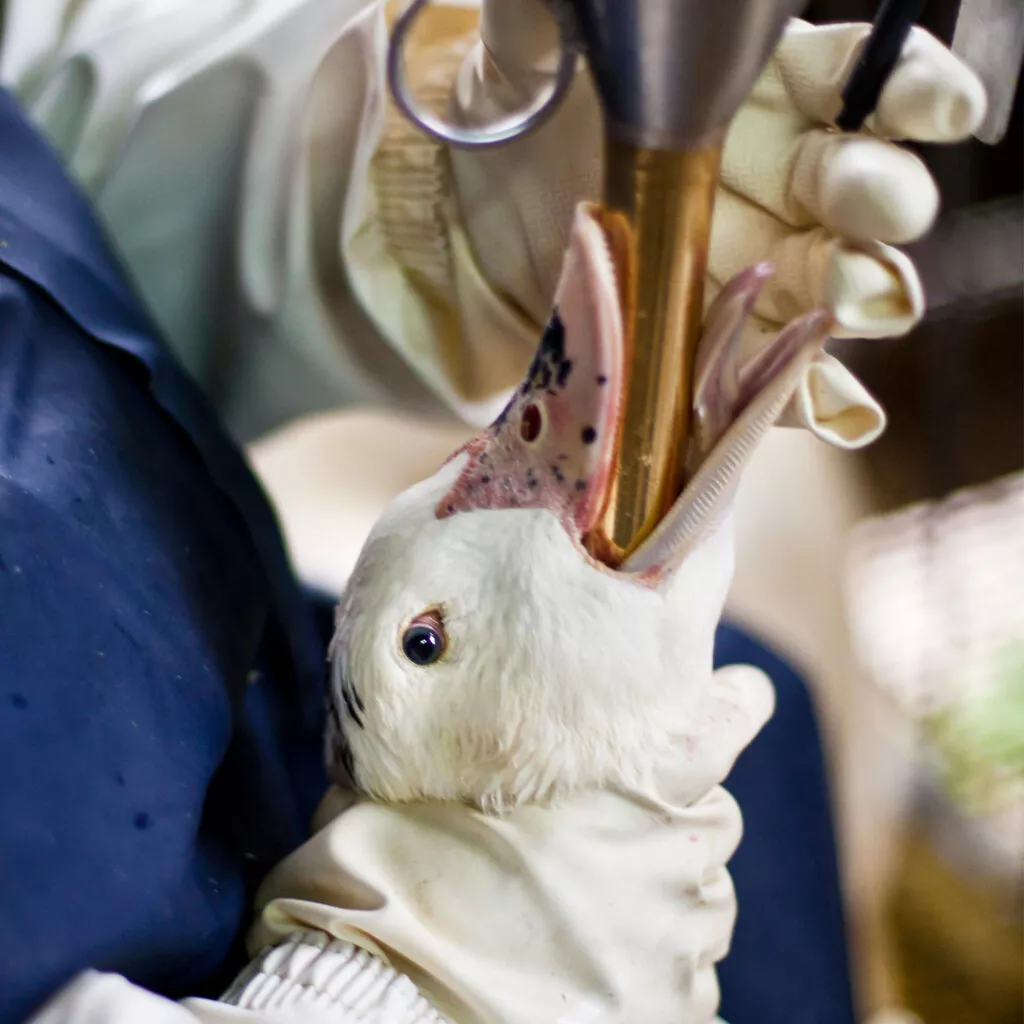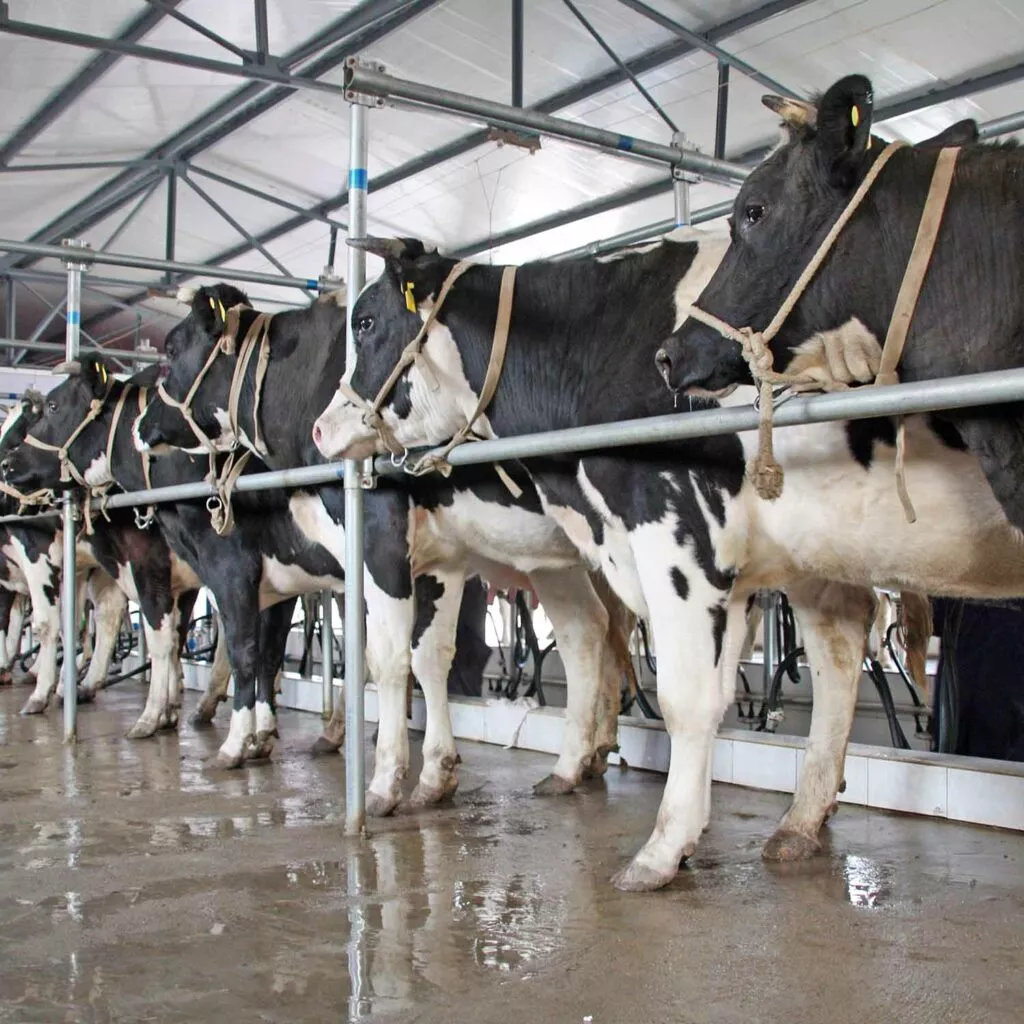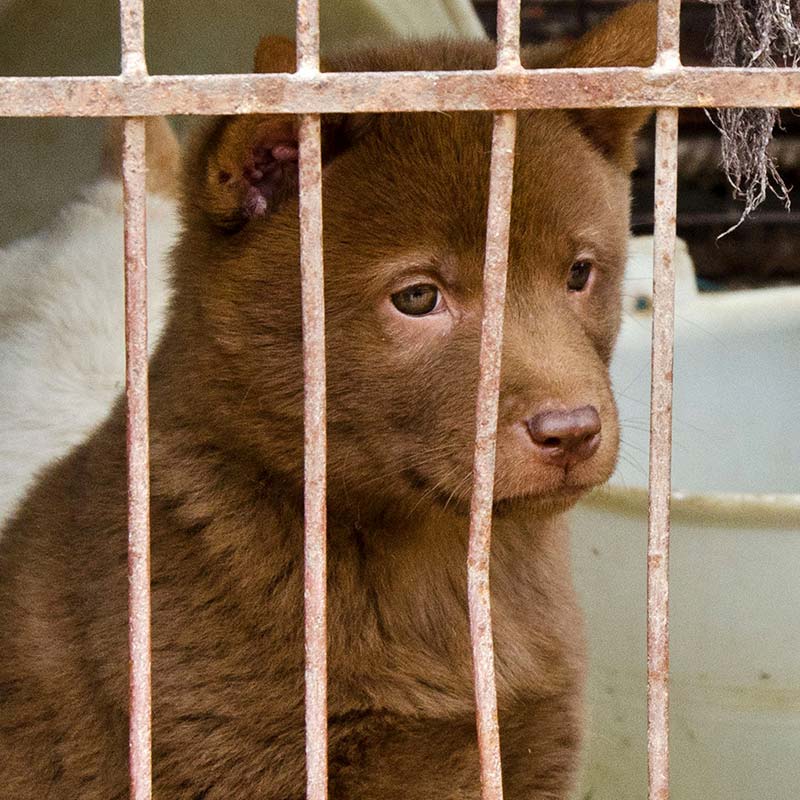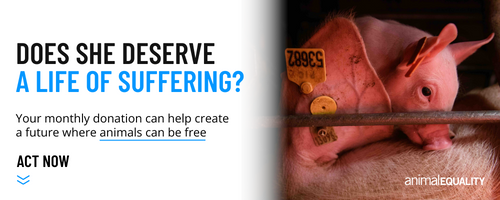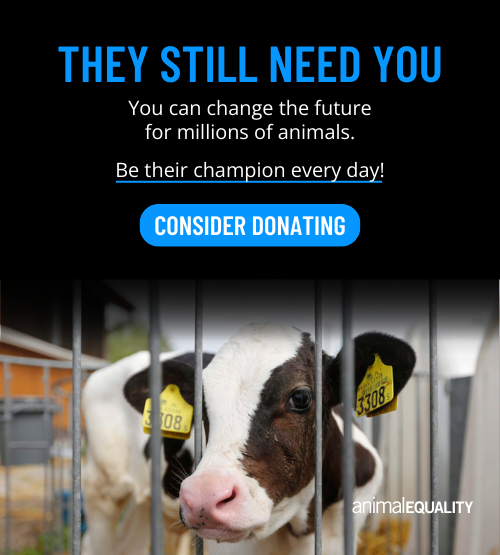

What It’s Like To Be An Undercover Investigator
Undercover investigators work tirelessly behind the scenes to capture some of the cruelest abuses and practices used by the meat industry today. The footage they obtain raises public awareness, shows the need for animal protection laws, and changes outdated practices and policies in some of the world’s largest companies.
But what’s life really like for an investigator? What do they experience inside factory farms? And how does your support impact the valuable work they do for animals? President Sharon Núñez and our International Director of Investigations, Sean Thomas, discuss our investigative work and answer your most critical questions.
What was the investigation that impacted you the most? (01:47)
+Sean: I would have to say it was the first time that I was working undercover at a pig farm. This would be in the late 1990s and the technology was very different from what we have now in terms of cameras. It was such an intense experience. It was probably the most violent situation that I’ve ever witnessed, and I learned a lot being on my own [and] not really having a mentor around me at the time. All of the things that I witnessed [were] just horrific abuse of these mother pigs that were kept on a breeding farm in North Carolina.
[I was] figuring out how to document this and how to do the actual job of working on a pig farm. It changed my view of investigations and how important they are. It was also an investigation that resulted in the first felony animal cruelty charges against workers on a factory farm in the U.S. It had this incredible impact emotionally within the legal system. And [it] just shaped how I wanted to conduct investigations in the future. A lot of what I pass on to investigators now is based from those experiences.
Sharon: Between 2011 and 2012, Animal Equality carried out one of the first investigations into rabbit farms to ever be conducted in Spain and one of the largest investigations in rabbit farms to ever be conducted in Europe. We investigated 72 farms and four rabbit slaughterhouses. And, of course, rabbits are beautiful animals and I felt a very strong connection.
But, specifically, during one of the investigations where I was actually joined by photographer Jo-Anne McArthur. We went into a farm to take some photos. As we were leaving, we noticed in one of the big trash cans there was a plastic bag. Then there was a little bit of movement, so we went over. We opened the bag and there was a live rabbit. We took the rabbit [and] we brought him with us immediately to a vet. We named him Guerullo. He was very tiny, very small. Unfortunately, Guerullo died a few hours later at the vet. He was so sick and his internal organs were so damaged that he couldn’t make it beyond the vet, beyond the farm.
I had a very strong emotional connection with that animal and it reminded me of how animals are so discarded. They’re just thrown into the trash when they’re still alive because there’s no economic profit that can be made from their lives. That’s something that is very present to us at Animal Equality. We see animals as sentient living beings, and we’re fighting an industry that sees animals as trash [and throws] them into the bin when there’s no economic benefit to their lives.
What led you to become an investigator? (06:06)
+Sean: I was interested in animal rights since I was a young child. At 10, I tried to become a vegetarian [but] didn’t have much support at the time from my family. Then was vegetarian again as a teenager, and then vegan at 18. In about 1990, I was vegan and just getting more involved in animal rights. At the time, I started a student animal rights group and I happened to live very close to a large laboratory breeding facility where all of the monkeys that were used in research at the university were being held.
At the time I was going through anthropology – I wanted to be a primatologist when I graduated. I just used that as a cover to go inside the laboratory and take some pictures and then launched this campaign. At the time, there weren’t a lot of images of farmed animals that demonstrated a lot of the things that we were talking about. We were always talking about the fact that pigs are castrated or animals are discarded. We were talking about all these things and people would say, “What proof do you have that this actually happens? You’re just fervent animal rights activists.”
That’s when I embarked on this journey of just traveling around with a video camera myself and then became involved with some other larger organizations. From then on I was undercover… I always say the only professional job I’ve actually had is doing investigations. Then [I] went directly from university into doing [investigations] until joining Animal Equality.
Sharon: When Animal Equality started, we started in 2006 in Spain, there was almost no footage of what happened inside factory farms in Spain. I remember we would stand outside Burger King or McDonald’s, or we would stand on the main plaza, and we would show these pictures of animals in farms and slaughterhouses in the U.S. Maybe they were even taken by Sean. People would say that doesn’t happen in Spain – that doesn’t happen here. And it became the realization that it does happen. We know it happens but we need to show it to the public. We need to have actual footage inside farms and slaughterhouses in Spain.
The first investigation we did as Animal Equality was as rudimentary as one of our Co-founders, Jose, getting on a bus and traveling to slaughterhouses in the north of Spain and filming as much as he could. We still use that footage today. It was on national newspapers in Spain and artist Banksy used it as part of one of his art installations. I quickly came to realize that if we wanted to do investigations of this magnitude we needed to get media attention and create public awareness about what was happening to animals. I needed to be involved, too. For me, it really was about wanting to tell people the stories and the cruelties that happened behind factory farms.
Are you vegan? (10:25)
+Sharon: Yes, I am vegan. I’ve been a vegan since 2001, so for 21 years. For me, it’s a fundamental part of who I am. I don’t understand doing the work that I do [and] dedicating my life to reducing the suffering of animals [but] contributing to that suffering in any way.
Sean: As soon as I went to university I became vegan [since] I was cooking for myself. I didn’t know anyone who was vegan at that time. I know the first nights of living by myself and trying to make vegan food, [I did] not realize how long you had to cook chickpeas before you could eat them – [that] was a rude awakening. But things have changed a bit since then and it’s so much easier to be vegan. There’s just no reason not to make that switch.
What does a typical day as an investigator consist of? (12:03)
+Sean: There are a lot of different days and I would say a lot of them are not the same. I’ll start with an experience here in the U.S. when I was working undercover and I would be taking jobs in slaughterhouses or on factory farms. You’re waking up extremely early, maybe at 4:30 in the morning, and preparing the camera equipment. [You’re] having to do your normal daily routine at the same time.
Oftentimes, I’d be driving up to 45 minutes just through these rural areas to get to the farm or to the slaughterhouse. You’re showering in. You’re doing all of the work that everyone is doing on the farm. At some of these breeding farms, there are litters of piglets being born every day and you’re just constantly working. Or, at the slaughterhouse, as soon as you arrive you’re bringing cows off the trucks. Or, with pigs, moving them around constantly. It’s very intense and it’s a lot of manual labor.
Usually, our shifts would be anywhere from eight to 12 hours of work where you might get 15-minute breaks and then a short lunch break. Afterward, the routine continues. If you’re working at a farm, you might get back home at about 4:30 in the afternoon, but then the second job begins and you have to switch back into the clerical work of the organization that goes into looking at the files and taking down your notes of what you saw and who did what.
Then trying to fall asleep and repeat it over and over again for weeks at a time. That’s before there’s just days and days of driving around and locating the facilities. When I was in Mexico going to slaughterhouses there, we weren’t working at the slaughterhouse but we were talking our way inside to be able to film. We would be up at two or three in the morning and arriving at the slaughterhouses before they opened and began work to negotiate our way inside and wait for the animals to arrive. It’s this intensity that lasts for days and, in some cases, for weeks and months.
What is the most difficult part of an investigation? (15:10)
+Sean: I think there are moments when you feel the excitement of [getting] inside. The filming was successful today and everything is working great. It’s maybe a couple of weeks later when you’re getting very tired from the monotony of the schedule and all of the additional organization and work that needs to be done. Just that repetition can be really straining.
There were some jobs at this pig farm in Oklahoma where I got some serious injuries to my shoulders and hands. You have to keep working through that and not jeopardize the integrity of the investigation by having to leave early or not being able to be in a position to film what you need to film. That mental exhaustion is the most difficult part to combat when you start doubting if it will have an effect after you’re done. Does it really matter if we stay an extra day to try and get a photo that’s better than the ones that we have or show something in a clearer way?
You have to fight through that and say it’s better to have a hundred photos or videos than just to have one and think that you’ve done enough. We know that [when] trying to convince people, they want to see it from a local perspective, or they want to see it from a company that makes some impact on their lives. That mental fortitude to keep pushing through and [being] able to get these clear examples of what’s happening to animals on factory farms can be the biggest challenge sometimes.
Have you ever been suspected of working undercover?
If so, how did you handle the suspicion? (18:28)
Sharon: I’ve never done undercover investigations like the ones that Sean has done and that we’re carrying out in some countries. I have entered farms with the farmer’s permission. It was in the farm where we found Guerullo that was in the plastic bag in the trash can, where, after hours taking photos and asking questions, one of the farmers…was playing along. He didn’t seem to be suspicious at all.
Then his son came [in] and he was clearly very suspicious of having three women there asking all sorts of strange questions about rabbits…He started asking [where we were from]. We’re like, ‘Oh, we’re from Canada and we just love rabbits.’ He wanted to see our passports and wanted all sorts of information. He wanted to take photos. Suddenly, we were in a big hurry, and we rushed out and drove away from the farm.
Thankfully, it was one of the last investigations we were doing in that area in Catalonia. That 70 farms that we investigated throughout Spain were…why the European Parliament in 2017 voted to improve the welfare of rabbits throughout the European Union. That went to the European Commission, which is like the Executive branch of the European Parliament. Unfortunately, they didn’t bring forward changes to rabbit welfare legislation as strong as we wanted them. But it was very important for public debate in Spain, public debate in Europe and, most importantly, public debate at the European Parliament.
Sean: I never had anyone confront me about working undercover. I definitely worked on farms where there was a lot of talk about what they would do if they ever found an undercover investigator working at the farm. In one place, [a worker] carried a gun in their truck all the time. They said if they ever found anyone they would go to their truck and get the gun and shoot them.
At another pig farm that I worked at, in the training for that farm job, they actually played the investigation that I did at the previous farm…I’d worked at the second largest [pig farm] and now I was working at the third largest. They played the investigation and I thought that they were about to say [they knew it was me]. And then they just turn to everyone in the room and said, ‘Okay, make sure that no one gets caught doing any of this type of stuff on the farm.’ It was just a matter of sitting there and keeping a straight face and then laughing about it to myself as I drove to work the next day.
Does it take a certain personality to be able to work as an investigator for Animal Equality? (23:18)
+Sean: A lot of people want to be an investigator and want to help animals. You can certainly help animals in many ways because a lot of people just aren’t suited to being investigators…You might be seeing something that’s horrible…and someone’s impulse who just wants to help animals might be to confront the farmer in that moment or grab one of those animals and run out and just have that momentary feeling that they’ve helped. But we’re looking for people who have that patience. It’s not a sprint. It’s a marathon.
Being able to have that sense of composure to be able to document these things very clearly and be able to deal with the fact that it’s not really an exciting job. I think a lot of people come in thinking that it’s very exciting when a lot of it can just be mundane, whether it’s constantly doing research or just the amount of travel and time away from home that can really disrupt people’s lives. The disruption to your normal life is why most people end up leaving the job. They want to help animals but they don’t want to always be seeing these things that they might take with them. It can really disturb people and you don’t get to go home to your friends every night and [talk about what you saw today] and work through it all the time.
It’s a very specific person, and there aren’t five boxes that we tick off with everyone. It’s a combination and some people arrive at that combination differently. Like myself, my mother’s been a journalist for over 60 years and ingrained in us this sense of discipline to facts and hard work and patience. Those things I relied on a lot. But other people have different skill sets that can also be beneficial.
It’s something that people really need to confront within themselves. Sometimes we do that after we receive applications and I might send someone a video and say, ‘Hey, watch this and just think, do you really want to be standing there and seeing this firsthand?’ Because it’s very different than watching it in a video. And then a lot of times people never reply after they watch a couple of videos and put themselves in that position. It’s not an easy choice but we’re always looking for people who are dedicated to fulfilling that role.
What does the job onboarding for Animal Equality’s investigators look like? (27:20)
+Sean: There’s an assessment that we have to do because, in the U.S., we’re doing employment investigations where most of your time is spent doing hard manual labor. There’s no way around that. That can be a real shock to the system for people who’ve never had to get up at 5 a.m every day and then be immersed in hard farm work…It’s industrial factory work…It’s really these warehouses and you’re walking on concrete and moving large animals all day long. I shouldn’t say farm or farm work because it’s not caring for animals. They’re not hiring farm animal stewards. They’re hiring people that can manage a warehouse full of animals that can pull out the dead pigs that die every single day.
When I was working on a breeding farm, that was one of the main things that you did there. There’d be dead pigs, dead piglets, and you’d go around and pull them out. If that was a mother pig, she would weigh maybe 260 pounds on a fattening farm or finish farm where the pigs are being prepared for slaughter. Every day, there are a couple in each barn that are dying. That’s your main work – pulling out the dead and putting them in big garbage heaps. On a hen farm where I worked, almost half the day was just going through all of the cages. In one barn there might be a hundred thousand hens and [you’re] just pulling out the dead ones. And you would have to go row after row after row with a flashlight because it’s kept so dark in these barns. So, we do a lot of physical evaluation before we even get into all of the other types of training.
What do the job duties of an investigator look like? (31:03)
+Sean: There’s a lot of research and preparations. In all of our countries, regardless of the tactic that we’re using, we want to break down these supply chains. We want to understand the relationship between companies. Who is supplying this company and where do these animals go? What labeling system is being used to promote them to the public to make it seem like there’s a higher standard of care on one farm versus another?
We’re doing all of this background research and then a lot of travel to evaluate these facilities. A lot of it is an intense amount of background…On these employment investigations, the day-to-day is this dual job. This intense work life…and then there’s a job at night. And the two interchange with each other seamlessly all day long. It’s almost a lifestyle versus a job that might last for a couple of weeks before we begin that planning stage for our next target. It’s ever-growing job duties.
How difficult is it to stand by and see cruelty firsthand and not be able to intervene? How do you remain calm and strong when faced with such difficult situations? (36:12)
+Sharon: I’ve visited about 50 farms in different countries. Most of the farms I’ve visited have been in Spain. A caged hen farm was the first investigation I was ever a part of. I’ve been lucky that I’ve been able to rescue some of the animals. Animal Equality in Europe carried out what are called open rescues, where we would enter different facilities in Europe and Spain, in the UK, in Italy. We would do an investigation. We would film as much as we could related to the conditions of the animals. One of the most impactful [investigations] are hens in cages where there are hundreds of hens in cages that are so small and an individual hen can’t even spread their wings or move. And I’ve been able to take some of these animals, bring them to the vet, and give them a new life at a sanctuary in freedom.
The transformation is immediate and it really helps you understand the quality of factory farming from an animal that never sees the [light of] day…is never able to scratch…is never able to walk…is never able to spread their wings…is never able to have any healthy behavioral relationships with other animals or humans. To take them to the vet and then bring them to a sanctuary and see the moments when they actually take those first steps in freedom. And for many of these animals, it’s the first time they’re able to walk…to take a dust bath…to be able to feel the sun. It’s truly special and magical but it’s not something that we can do on a regular basis.
Sean: When I was working on those first farms, you’re confronted by just the enormity of this issue. At the first pig farm where I worked, on that very first day, the manager beat a mother pig to death with a crowbar and cut her open. [He] said, ‘Okay, everyone. Get those piglets out of her and resuscitate them,’ because she could not. She was too sick to deliver them…It was such a shock to be watching this animal be killed and then have the person say, ‘Okay, now let’s save the babies.’
It was this moral idea that didn’t make any sense except for the fact that these are not animals – they are products in the industrial factory farm setting…When I left the farm that first day I cried driving back home and was horrified at what I’d seen. Then I actually said, ‘I’m not going to cry anymore about this because that’s for myself. The tears that I’m shedding now are just for myself.’ We have to show more and more to the world what is actually happening and you have to set aside your own feelings in those moments.
How does Animal Equality choose which slaughterhouse to investigate? (40:56)
+Sean: That goes back into the research strategy that [we] were talking about in terms of wanting to link [an] legislation. Whether it’s like what we’re doing in Mexico, where the investigations are the basis for legislation that is proposed. And we’ve been successful in Mexico. It’s absolutely amazing how we’re fueling that legislative process. Or, in Brazil, where we want to counteract measures that are being passed that will reduce protections for animals. They want to remove inspectors from slaughterhouses and allow slaughterhouses to do self-inspection. It’s very similar to a program that’s in the test phase in the U.S. It’s a high-speed slaughter for pigs and it allows companies to increase the speed and do self-reporting for many of the points in the slaughterhouse.
We want to be able to counteract those things. We would want to be able to do the research into which slaughterhouses are part of this program or which slaughterhouses are connected to a company that we want to influence. All of that goes into this larger matrix that we’re trying to use to strategize and have the most impact with these investigations.
How are investigators able to cope with what they see and what resources are available to them? (46:07)
+Sean: We’re doing a lot of screening in [the] first step and then a lot of preparation for what people will experience and what they’ll encounter in those different kinds of harrowing situations that they might be faced with…I get phone calls after work from the investigators who say, ‘I’m so tired. I’m so exhausted. The facility is working us 14 hours and then we have to go back tomorrow and go right back to work at 7 00 a.m and I only have four hours of sleep. Can I just do my report on the weekend?’ And we talk through all of these things and share that experience and have that outlet available to them.
We also have counseling services for people who really feel like they’re overwhelmed by what they’ve seen and want to take a break from doing that work. It is a very difficult thing to be a part of and most of that just comes from the intense amount of preparation that we’re doing that people aren’t overwhelmed in those moments.
Were you ever able to get any farms or slaughterhouses shut down? (48:30)
+Sharon: Yes, absolutely. I think we’ve calculated that thanks to Animal Equality’s investigations, about 90 facilities have closed. Animal Equality did an investigation into the dog and cat meat trade in China. After that investigation, we worked with authorities in the country and we managed to get 44 stalls in a market that were selling cat and dog meat closed. And actually, related to this investigation, our Executive Director in Italy, Alice, was just at the Italian Senate this week speaking about animal cruelty and speaking about the work that Animal Equality has done to document the slaughter of cats and dogs in China.
Another example is the investigations we did in Mexico as part of a campaign that was called Enemy of the Planet where we documented, through drone footage and with investigations, severe violations of environmental laws in Mexico. [We] managed to get 44 of those farms shut down for violations of environmental regulations. This isn’t necessarily one of our key strategies within the organization. We always want to make sure that we’re able to achieve system change – getting rid of cages, improving the welfare of chickens, and passing laws, passing legislation, that protects animal welfare. It’s definitely litigation that we pursue when it’s possible and it is possible in some cases.
Sean: We don’t always have the perfect response from law enforcement in the U.S. It could be very difficult to have them engage on some of these issues. We might see this horrific cruelty and someone from that community says what you’re watching is just what happens on a farm and you’re just too sensitive. [For] a lot of these investigations, what we’re trying to do is break down this barrier between the fact that animal cruelty laws are not designed just to protect dogs and cats. They’re meant to prevent cruelty to all animals. A lot of law enforcement is not aware of that…We have to do a lot of work with them to say the law is there to protect animals and you’re thinking that because they are going to be killed for meat they shouldn’t be protected at any point along the way. And it’s an error.
One of our most recent efforts to further our investigative goals is with the Foster Farms lawsuit that we filed in California. Because law enforcement was unwilling to engage with us on the cruelty that we documented at the Foster Farms hatchery in California, we have filed a lawsuit to seek damages as a result of that company’s actions in their hatchery.
What are your thoughts on Ag-Gag laws? (52:33)
+Sean: Ag-Gag laws are just very blatant barriers that the industry lobbies for…to prevent activists and journalists from taking pictures of animals in a factory farm or a slaughterhouse. There are various versions of these laws right now. They’re active in a couple of states – Montana, North Dakota, Iowa, Missouri, Arkansas, and Alabama. They’re blatantly unconstitutional and it’s purely a way that the industry says [they] don’t want to change [their] behavior and continue [to] make immense amounts of profits from the suffering of animals.
We’re part of coalition efforts to overturn these laws and it’s been successful, most recently in North Carolina. I think we’ll see these laws fail the test in the courts. In the meantime, it does restrict our ability to even show the public what happens to animals in these situations.

